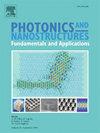基于硅绝缘体微环谐振器的超紧凑铁磁流体渗透磁场传感器
IF 2.9
3区 物理与天体物理
Q3 MATERIALS SCIENCE, MULTIDISCIPLINARY
Photonics and Nanostructures-Fundamentals and Applications
Pub Date : 2025-07-10
DOI:10.1016/j.photonics.2025.101424
引用次数: 0
摘要
在本文中,我们的目标是提出一个紧凑的高q因子的磁场传感器,是CMOS兼容。因此,我们提出了一种新型的微环谐振器(MRR)设计,使用绝缘体上硅(SOI)平台,在槽腔中填充磁性铁磁流体。首先,我们开始设计开槽MRR,通过调整轨道宽度、高度和开槽宽度的尺寸来实现最大的光约束。优化后,轨道宽度为250 nm,槽宽度为100 nm,高度为220 nm,具有最大的约束因子,形成了所提出的磁场传感器的基本设计。环形半径为50μm的开槽MRR器件在外加磁场作用下,有效指数发生较大变化,导致相位和传输特性发生显著变化。通过对所提出模型的传输特性的连续下降,观察到5.399 pm/Oe的灵敏度。为了设计一种高效的磁传感器,利用轨宽和槽宽优化定性分析,即质量因子(q因子)和消光比(ER)。结果表明,轨宽为250 nm和槽宽为125 nm的尺寸可提供约6.5 × 104的高q因子,ER为37 dB。这一结果为集成光子学和磁场操纵的进一步发展铺平了道路。本文章由计算机程序翻译,如有差异,请以英文原文为准。

Ultra-compact ferrofluid infiltrated magnetic field sensor utilizing microring resonator in silicon-on-insulator platform
In this paper, we aim to propose a compact high Q-factor magnetic field sensor which is CMOS compatible. Hence, we have proposed a novel micro-ring resonator (MRR) design using a silicon-on-insulator (SOI) platform where a magnetic ferrofluid is filled in the slot cavity. First, we initiated the design of slotted MRR for maximal light confinement by tuning the dimensions of rail widths, height, and slot width. After optimization, the rail width of 250 nm and the slot width of 100 nm with a height of 220 nm are reported to have a maximal confinement factor, forming the base design of the proposed magnetic field sensor. The application of an external magnetic field to the slotted MRR device with a ring radius of resulted in a considerable change in the effective index, leading to significant variations in phase and transmission characteristics. A sensitivity of 5.399 pm/Oe is observed through consecutive dips in the transmission characteristics for the proposed model. To design an efficient magnetic sensor, the qualitative analysis, namely the quality factor (Q-factor) and extinction ratio (ER) are optimized by using rail widths and slot width. The reported results infer that the dimension of rail widths of 250 nm and slot width of 125 nm offer a high Q-factor of approximately 6.5 104 with an ER of 37 dB. The results pave the way for further advancements in integrated photonics and magnetic field manipulation.
求助全文
通过发布文献求助,成功后即可免费获取论文全文。
去求助
来源期刊
CiteScore
5.00
自引率
3.70%
发文量
77
审稿时长
62 days
期刊介绍:
This journal establishes a dedicated channel for physicists, material scientists, chemists, engineers and computer scientists who are interested in photonics and nanostructures, and especially in research related to photonic crystals, photonic band gaps and metamaterials. The Journal sheds light on the latest developments in this growing field of science that will see the emergence of faster telecommunications and ultimately computers that use light instead of electrons to connect components.

 求助内容:
求助内容: 应助结果提醒方式:
应助结果提醒方式:


